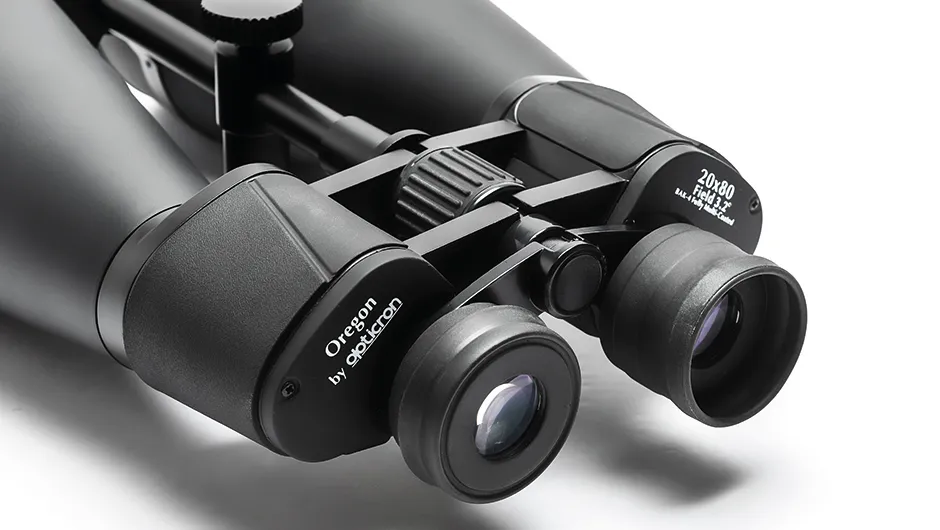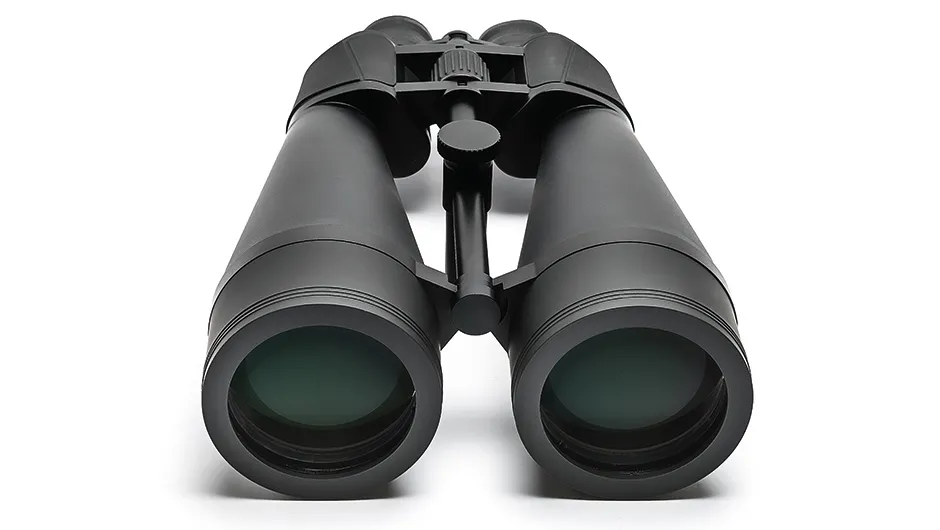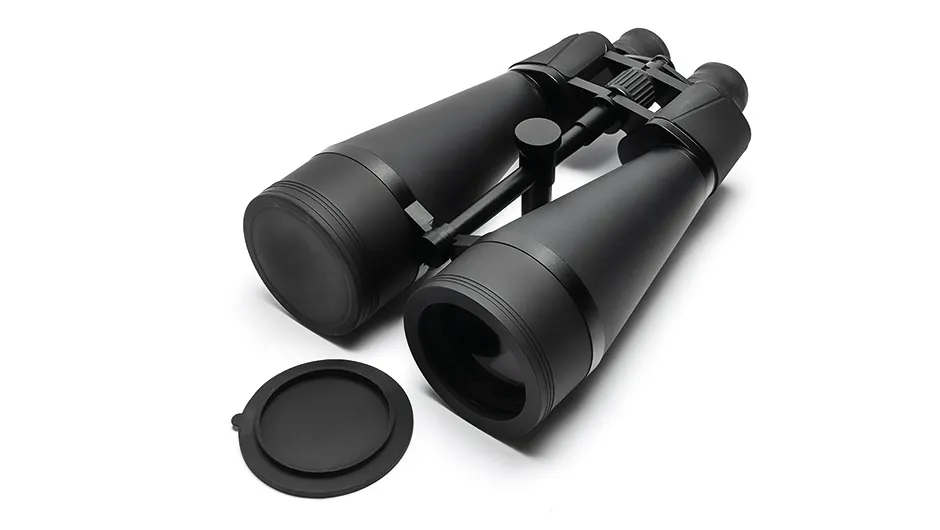Our interest is naturally piqued when some budget-priced, 80mm aperture binoculars come onto the market, such as the Opticron Oregon Observation 20x80.They come with a zip-fastening vinyl case with a rain flap that’s secured with Velcro tabs.
Unusually, the case also has a removeable, Velcro-sealed, rigid inner case with internal straps that hold the binoculars securely to reduce the effects of any bumping around during transportation.
Despite the extra protection the straps offer, we found them to be a nuisance in everyday use because it’s almost impossible to slip the binoculars back into their case without them snagging on the straps.
Thankfully, there’s a simple solution to this: turn the liner inside out so the straps are between the rigid inner and the outer cover, and therefore unable to snag the binoculars when you slide them into the case.
The eyepiece cover is a single, flexible rain guard-type you can tether to the strap.
Typical of its design, it limits the maximum distance between the eyepieces, but it has the advantage that you can use it when the rubber eye cups are folded down.
With the eye cups unfolded, spectacle wearers are usually unable to get their eyes close enough to the eyepieces to see the entire field of view.
The eye cups of these Oregon Observation binoculars fold down to 2mm above the surface of the lenses, so 15mm of the specified 17mm eye relief is available. We found this to be sufficient to let us to see the entire field of view, even with our glasses on.
The close focus of the test binoculars was about 30m and the focal range of the binoculars extends ‘beyond’ infinity, so most people with mild focus defects in their vision should be able to focus these binoculars and observe without spectacles.
These binoculars appear on our list of the best binoculars for astronomy and stargazing

Clear, crisp views
When we shone a bright light into one of the objective lenses, only a small amount of light was reflected from its surface or the internal components, with the exception of a reflection that appeared to come from a prism surface.
This illustrates the effectiveness of the anti-reflective multi-coatings.
Control of stray light is also good, with minimal glare when the Moon or a bright streetlight was just outside the edge of the field of view.
We tested the binoculars under a variety of sky conditions, mounted on a photographic tripod with a fluid video head.
Stars snapped to a good focus, which looked consistent over the central 80 per cent of the field of view.
There was some off-axis chromatic aberration on the Moon’s terminator and limb, but generally both colour correction and colour rendition were good.
It was possible to easily to distinguish the colours of Alderamin (Alpha (α) Cephei), Zeta (ζ) Cephei, Delta (δ) Cephei and Mu (μ) Cephei.

These binoculars come into their own on extended deep-sky objects.
The Orion Nebula was bright, showing good structure, and we could distinguish all four stars of the Trapezium (Theta (θ) Orionis).
The galaxies M81 and M82 were easy to see and the differences between them were obvious.
The Andromeda Galaxy, M31, nearly filled the field of view and we could detect the more abrupt cut-off owing to the dust lane on the near side.
The normally difficult-to-see M33 and M101 galaxies were easily spotted when they were high in the sky, especially when we used averted vision.
Although the Ring Nebula, M57, did not appear as a distinct ring, it was easy to detect and had the appearance of a disc with a darker middle.
If you fancy trying a larger-than-standard pair of binoculars without breaking the bank, the Opticron Oregon Observation 20x80s should certainly be on your shortlist, particularly if you’re new to binocular astronomy.
These binoculars are pleasant to use, have no glaring faults and also come with a five-year UK guarantee to provide significant peace of mind.

Large, multi-coated optics
Like telescopic astronomers, aficionados of binoculars have a constant desire to get more light into their instruments.
All else being equal, an 80mm objective lens will collect more than two-and-a-half times as much light as the 50mm lenses that many astronomers favour for astronomy with hand-held binoculars.
The result is not only that fainter point objects (stars) become visible, but that more magnification is possible without overly dimming extended objects (for example galaxies, nebulas).
These, in turn, allow you to see more detail in your target object, giving more satisfying observation.
Of course, there’s not a lot of point in gathering more light if it’s not transmitted to your eye.
It’s common practice with budget binoculars for the aperture to be stopped down internally, presumably to improve the image quality.
Here, the reduction is minimal: we measured the effective aperture as 76mm.
Additionally, the Opticron Oregon Observer’s lenses are fully multicoated, which means that compared to simple, coated lenses, at least 10 per cent more light gets through to your eye.

Objective lens caps
Poorly fitting objective caps are about as useful as a chocolate fireguard.Luckily, the plug-in objective caps on these binoculars are excellent; they provide a tight-fitting seal and can only be removed by using the tabs provided.If you lose them, it won’t be because they fell off in a field somewhere.
Objective lenses
The objectives are recessed 16mm into their tubes, which are 11mm thick. This offers good protection against impact and accidental touching, reducing the likelihood of their surfaces getting damaged or scuffed. It also helps to reduce glare from objects just outside the field of view.
Central mounting bar
As well as conferring rigidity between the optical tubes, the central mounting bar has a sliding mounting position, which enables you to easily balance the binoculars on the mount.This design also keeps the binoculars’ centre of mass close to the mounting head’s altitude fulcrum; this reduces balance asymmetry at different altitudes.
Folding rubber eye cups
The soft rubber eye cups easily conform to the shape of your eye sockets, making them comfortable to use.They fold down to give an effective eye relief of 15mm, which we found to be adequate to allow us to wear spectacles for observing.
Carry-case
The case has side rings so you can use it like a shoulder bag, but also has three rings on the back, so you can use it like a rucksack and distribute the weight evenly across your back rather than all on one shoulder.
Vital stats
Price£149.00
Aperture80mm
Weight2.2kg
SupplierOpticron
Telephone01582 726522
Website:www.opticron.co.uk
This review originally appeared in the April 2018 issue of BBC Sky at Night Magazine

